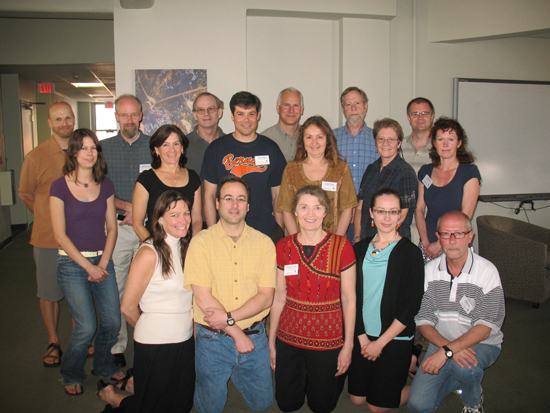NCEAS Working Groups
Genetic monitoring: Development of tools for conservation and management
Project Description
Genetic monitoring has the potential to become a valuable tool for resource managers in the management and conservation of wild populations of plants and animals. Rapid recent advances in molecular genetic techniques now make it relatively easy and inexpensive to quantify temporal changes in the genetics of populations over tens or even hundreds of years. However, it is currently unknown under what circumstances genetic monitoring would provide valuable information or what genetic data are required for effective genetic monitoring. This Working Group will address these issues in order to provide guidance for resource managers and policy makers. We will also evaluate the potential for using genetic monitoring of candidate genes likely to be affected by climate change and other forms of stress in order to understand evolutionary responses to environmental changes. The outcome of this Working Group will be rigorous and practical guidelines for the design of genetic monitoring strategies and should lead to improved assessments of population trends and processes.

Principal Investigator(s)
Fred W. Allendorf, Michael K. Schwartz
Project Dates
Start: March 1, 2008
End: November 1, 2009
completed
Participants
- Fred W. Allendorf
- University of Montana
- C. Scott Baker
- Oregon State University
- Dave Gregovitch
- NOAA, Southwest Fisheries Science Center
- Michael M. Hansen
- Technical University of Denmark
- Jennifer Jackson
- Oregon State University
- Katherine C. Kendall
- US Geological Survey (USGS) Glacier Field Station
- Linda Laikre
- Stockholm University
- Kevin S. McKelvey
- USDA Forest Service
- Brad H. McRae
- University of California, Santa Barbara
- Maile C. Neel
- University of Maryland
- Isabelle M. Olivieri
- Université de Montpellier II
- Nils Ryman
- Stockholm University
- Michael K. Schwartz
- USDA Forest Service
- Ruth Shortbull
- University of Montana
- Jeffrey Stetz
- University of Montana
- David Tallmon
- University of Alaska
- Barbara L. Taylor
- NOAA, Southwest Fisheries Science Center
- Christina Vojta
- USDA Forest Service
- Donald M. Waller
- University of Wisconsin, Madison
- Robin S. Waples
- NOAA, Northwest Fisheries Science Center
Products
-
Presentations / 2007
Monitoring genetic change in natural populations
-
Presentations / 2010
Genetic monitoring of natural populations
-
Presentations / 2011
An introduction to genetic monitoring
-
Presentations / 2011
Genetic monitoring, the wildlife point of view
-
Journal Article / 2009
Sixty years of anthropogenic pressure: A spatio-temporal genetic analysis of brown trout populations subject to stocking and population declines
-
Journal Article / 2012
Monitoring adaptive genetic responses to environmental change
-
Journal Article / 2012
Guidelines for collecting and maintaining archives for genetic monitoring
-
Journal Article / 2011
Promoting collaboration between livestock and wildlife conservation genetics communities
-
Presentations / 2009
Who cares about the genes? Genetic diversity is neglected in international conservation policy.
-
Journal Article / 2010
Compromising genetic diversity in the wild: Unmonitored large-scale release of plants and animals
-
Journal Article / 2010
Genetic diversity is overlooked in international conservation policy implementation
-
Journal Article / 2010
Neglect of genetic diversity in implementation of the convention on biological diversity
-
Presentations / 2010
Targets and indicators for monitoring genetic variation for resilience and future adaptation.
-
Journal Article / 2010
Estimation of census and effective population sizes: The increasing usefulness of DNA-based approaches
-
Journal Article / 2013
Estimation of effective population size in continuously distributed populations: There goes the neighborhood
-
Journal Article / 2010
Interaction of climate, demography and genetics: A ten-year study of Brassica insularis, a narrow endemic Mediterranean species
-
Journal Article / 2013
Monitoring reveals two genetically distinct brown trout populations remaining in stable sympatry over 20 years in tiny mountain lakes
-
Journal Article / 2014
Samples from subdivided populations yield biased estimates of effective size that overestimate the rate of loss of genetic variation
-
Presentations / 2008
Genetic monitoring of carnivores
-
Presentations / 2009
How well do effective population size estimators reflect changes in abundance
-
Dissertation or Thesis / 2010
The importance of multiple study areas in landscape genetics: The American black bear in the Rocky Mountains
-
Dissertation or Thesis / 2008
Monitoring grizzly bear populations with bear rub tree surveys
-
Journal Article / 2011
Genetic monitoring for managers: A new online resource
-
Presentations / 2009
When are genetic methods useful to estimate contemporary abundance and population growth?
-
Journal Article / 2010
When are genetic methods useful for estimating contemporary abundance and detecting population trends?
-
Journal Article / 2012
Detecting population recovery using gametic disequilibrium-based effective population size estimates
-
Journal Article / 2009
Modelling evolutionary processes in small populations: Not as ideal as you think
-
Journal Article / 2010
Linkage disequilibrium estimates of contemporary Ne using highly variable genetic markers: A largely untapped resource for applied conservation and evolution
-
Journal Article / 2010
Spatial-temporal stratifications in natural populations and how they affect understanding and estimation of effective population size
-
Journal Article / 2011
Estimating contemporary effective population size on the basis of linkage disequilibrium in the face of migration
-
Journal Article / 2014
Effects of overlapping generations on linkage disequilibrium estimates of effective population size
